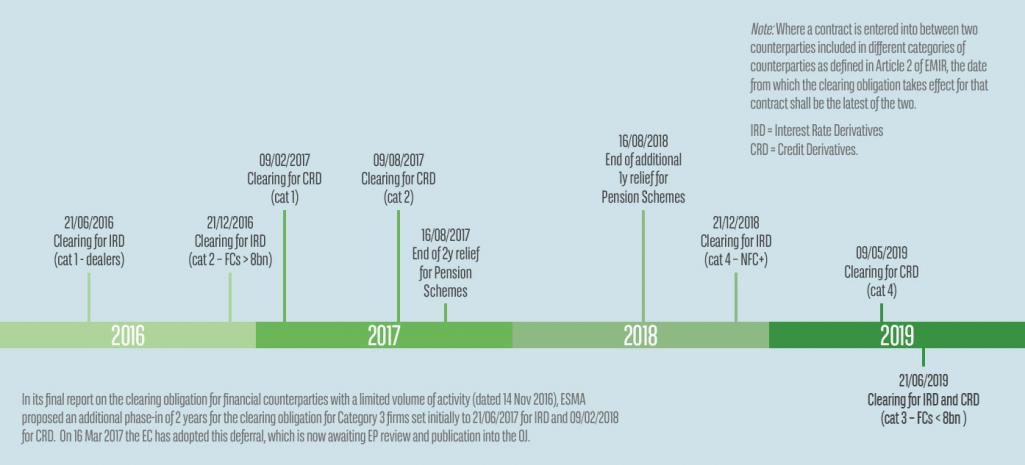The 2008 financial crisis
highlighted inefficiencies in the over-the-counter (OTC) derivatives market,
especially around counterparty risk and transparency. Following the G20
Pittsburgh Agreement in 2009, the regulators’ approach to addressing these
included clearing transactions through a central counterparty (CCP) or, if they
cannot be cleared, subjecting them to mandatory exchanges of collateral.
While this sounds obvious,
implementation is another story for regulators and financial (and nonfinancial)
institutions, who must revamp processes across a number of business areas,
especially collateral management.Why the need for collateral?
Centralised clearing
obligations on interest-rate and credit derivatives under Dodd-Frank have been
around for several years, but the European Market Infrastructure Regulation
(EMIR) is being implemented through a piecemeal or gradual approach. This will require all financial organisations to adapt post-trade processes
to ensure compliance with their clearing obligations.
Some pension funds, which have
been granted an exemption until August 2018 at the latest, are investigating
the benefits of clearing their interest-rate swaps, given the lower spreads
offered by banks on long-dated trades.
Meanwhile, non-standard or
insufficiently liquid OTC derivatives will remain outside clearing obligations,
as will instruments that benefit from an explicit clearing exemption. Tougher
margin requirements will be imposed on uncleared OTCs (including FX).
The US, Canada and Japan went
live first (in September 2016) for entities above USD 3 trillion notional
equivalent of uncleared derivatives, imposing exchanges of daily initial margin
(IM) and variation margin (VM).
The EU, Switzerland and a
handful of Asia-Pacific markets, including Australia, South Korea, Hong Kong
and Singapore, are expected to go live during 2017.
Mandatory daily VM was
introduced in March 2017 for all financial institutions in the US and EU, but
with some subtle differences. For instance, the US exempts physically settled
FX forwards and swaps from the variation margin requirements, while the EU does
not. In fact, the US imposes a same-day settlement of the collateral, while the
EU’s latest technical standards seem to aim at more flexibility. Without
equivalence and substituted compliance, parties to cross-border trades will
probably have to comply with the ‘toughest’ regulatory provisions. But given
the late publication of the final rules and the enormous amount of contract
“repapering” across the whole industry, the regulators have granted an
additional leeway (until 1st September in the US, while in the EU no
hard deadline has been set but the European Supervisory Authorities have stated
that each competent authority should apply risk-based supervisory powers and
that firms must be able to demonstrate their reasonable efforts in the
compliance process). As a result many firms are still catching up with the
rules as of today.
Operational headaches
Although a large part of the market is already collateralised with VM, the stringent nature of the regulation obliges many market participants to renegotiate collateral agreements to bring them in line with the regulation. The industry issued the International Swaps and Derivatives Association (ISDA) 2016 VM protocol to facilitate the compliance process. One of the biggest difficulties is that many parties need to maintain a legacy Credit Support Annex (CSA) for trades entered into before March 2017 (alongside a ‘new’ or ‘replica’ CSA, as the case may be) for trades made after that date. The impact on operational chains needs to be considered carefully, as the application of the legacy or the new/replica CSA differs, depending on trade lifecycle events.Firms must put efficient processes in place to meet the new margin rules, but the dual-CSA feature is not the only complication. Items such as cross-currency haircuts, IM thresholds and minimum-transfer amounts (e.g. how these would be split under different umbrella CSAs) must be analysed carefully: the devil is in the detail.
The provisions related to IM will come into force gradually; more firms will come under these obligations when the notional threshold reaches EUR 8 billion equivalent in 2020. The provisions oblige firms to exchange IM and segregate it with a third-party custodian, forbidding the reuse of these assets. The contractual framework is specific and needs the early involvement of firms’ legal departments.
For IM, regulators authorise firms to make use of a table-based approach or an internal model. While the former can be a pragmatic solution for firms with smaller portfolios, it may cause substantial funding costs for those with larger ones. For firms choosing the internal model, the ISDA has coordinated the roll-out of the Standard Initial Margin Model (SIMM). This model relies on a ‘sensitivity-based approach’ which captures the main risk factors of each asset class (through their respective deltas and vegas in the case of products with optionality) and the non-linearity of risks through a ‘curvature’ factor.
The SIMM also incorporates weightings and correlations within the same asset class. For some asset classes (equity and credit), where the underlying activity sector could be subjective, central crowdsourcing has been implemented to allow consensus among participants. The use of the SIMM, however, implies regular audit processes, frequent back-testing and possibly validation by the supervisor. The challenge will be to ensure that (1) calculation, (2) agreement of calls and (3) settlement in a segregated custody structure can happen as quickly as possible.

Connectivity between derivatives systems, pricers and collateral tools will be key for both VM and IM. Moreover, the same-day settlement imposed in the US and other jurisdictions also carries a set of constraints and will drive the market to the most straight-through processing solutions. For instance, Acadiasoft Marginsphere already enables some market participants to exchange their margin calls through a centralised utility and automatically agree or dispute the margin calls. For IM, this will facilitate the investigation of disputes.
Why is collateral management not straightforward?
Concerns of a ‘collateral squeeze’ or ‘collateral shortfall’ have broadly subsided. The market now does not fear an overall shortfall so much as a velocity issue, which would result in the OTC market grinding to a halt. Sufficient high-grade collateral seems to be available for OTC users currently, but there are complications.Basel III rules are forcing banks to hold high-quality liquid assets (HQLAs) while capital and especially liquidity constraints (liquidity coverage ratio (LCR) and net stable funding ratio (NSFR)) are leading to some pressure on repo market activity. Many buy-side firms are sitting on large inventories of high-grade bonds which, despite yielding negative interest, are viewed as relatively risk-free assets.
Sourcing available collateral requires good connections between participants. The main problem for collateral users is its liquidity and velocity, which must be posted, sometimes on the same day, to the relevant counterparty. The biggest risk OTC derivatives users will face is a sudden demand for additional collateral at times of severe market volatility.
How can services providers help?
Effective collateral management is key. Service providers, such as custodian banks, can offer their clients a wide array of solutions, including robust and highly automated systems connected to market utilities, secured credit facilities and a triparty platform that can facilitate access to liquidity providers, helping market participants address collateral challenges.Such solutions are only valid if the collateral is settled and held securely by the collateral service provider, acting as custodian, with the appropriate account structure.
Clearing and bilateral margining will inevitably become the norm very quickly and firms need to be ready to meet regulatory deadlines.
The clock is ticking.
Moreover, margining rules across major economies are not being created in tandem.
Working with a global provider across these markets is crucial to understanding regional differences and dealing with the process in optimum fashion. Clearing and bilateral margining will inevitably become the norm very quickly and firms need to be ready to meet regulatory deadlines. The clock is ticking.
This article was first published on Insights, by BNP Paribas Securities Services.

